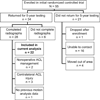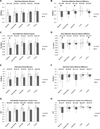Decreased Knee Joint Loading Associated With Early Knee Osteoarthritis After Anterior Cruciate Ligament Injury
- PMID: 26493337
- PMCID: PMC4703470
- DOI: 10.1177/0363546515608475
Decreased Knee Joint Loading Associated With Early Knee Osteoarthritis After Anterior Cruciate Ligament Injury
Abstract
Background: Anterior cruciate ligament (ACL) injury predisposes individuals to early-onset knee joint osteoarthritis (OA). Abnormal joint loading is apparent after ACL injury and reconstruction. The relationship between altered joint biomechanics and the development of knee OA is unknown.
Hypothesis: Altered knee joint kinetics and medial compartment contact forces initially after injury and reconstruction are associated with radiographic knee OA 5 years after reconstruction.
Study design: Case-control study; Level of evidence, 3.
Methods: Individuals with acute, unilateral ACL injury completed gait analysis before (baseline) and after (posttraining) preoperative rehabilitation and at 6 months, 1 year, and 2 years after reconstruction. Surface electromyographic and knee biomechanical data served as inputs to an electromyographically driven musculoskeletal model to estimate knee joint contact forces. Patients completed radiographic testing 5 years after reconstruction. Differences in knee joint kinetics and contact forces were compared between patients with and those without radiographic knee OA.
Results: Patients with OA walked with greater frontal plane interlimb differences than those without OA (nonOA) at baseline (peak knee adduction moment difference: 0.00 ± 0.08 N·m/kg·m [nonOA] vs -0.15 ± 0.09 N·m/kg·m [OA], P = .014; peak knee adduction moment impulse difference: -0.001 ± 0.032 N·m·s/kg·m [nonOA] vs -0.048 ± 0.031 N·m·s/kg·m [OA], P = .042). The involved limb knee adduction moment impulse of the group with osteoarthritis was also lower than that of the group without osteoarthritis at baseline (0.087 ± 0.023 N·m·s/kg·m [nonOA] vs 0.049 ± 0.018 N·m·s/kg·m [OA], P = .023). Significant group differences were absent at posttraining but reemerged 6 months after reconstruction (peak knee adduction moment difference: 0.02 ± 0.04 N·m/kg·m [nonOA] vs -0.06 ± 0.11 N·m/kg·m [OA], P = .043). In addition, the OA group walked with lower peak medial compartment contact forces of the involved limb than did the group without OA at 6 months (2.89 ± 0.52 body weight [nonOA] vs 2.10 ± 0.69 body weight [OA], P = .036).
Conclusion: Patients who had radiographic knee OA 5 years after ACL reconstruction walked with lower knee adduction moments and medial compartment joint contact forces than did those patients without OA early after injury and reconstruction.
Keywords: anterior cruciate ligament; contact force; knee moment; loading; osteoarthritis.
© 2015 The Author(s).
Conflict of interest statement
One or more of the authors has declared the following potential conflict of interest
Figures


References
-
- Barenius B, Ponzer S, Shalabi A, Bujak R, Norlén L, Eriksson K. Increased risk of osteoarthritis after anterior cruciate ligament reconstruction: a 14-year follow-up study of a randomized controlled trial. Am J Sports Med. 2014;42(5):1049–1057. - PubMed
-
- Butler RJ, Minick KI, Ferber R, Underwood F. Gait mechanics after ACL reconstruction: implications for the early onset of knee osteoarthritis. Br J Sport Med. 2009;43(5):366–370. - PubMed
Publication types
MeSH terms
Grants and funding
LinkOut - more resources
Full Text Sources
Other Literature Sources
Medical

